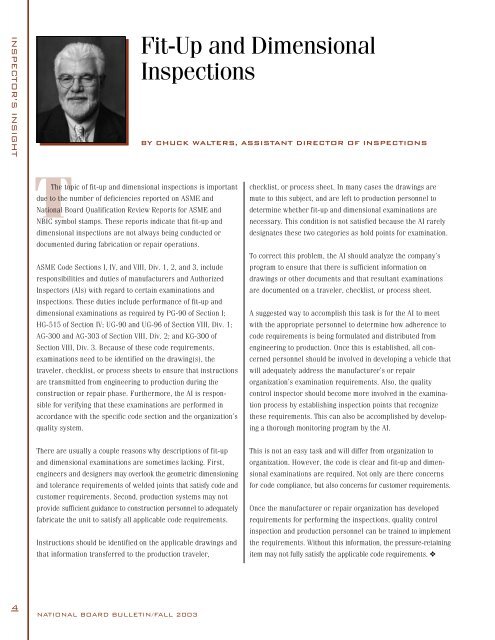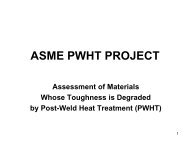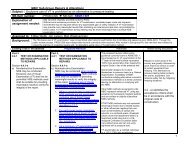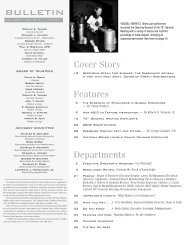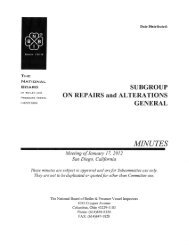bulletin - The National Board of Boiler and Pressure Vessel Inspectors
bulletin - The National Board of Boiler and Pressure Vessel Inspectors
bulletin - The National Board of Boiler and Pressure Vessel Inspectors
Create successful ePaper yourself
Turn your PDF publications into a flip-book with our unique Google optimized e-Paper software.
INSPECTOR’S INSIGHT<br />
4<br />
T<strong>The</strong> topic <strong>of</strong> fit-up <strong>and</strong> dimensional inspections is important<br />
due to the number <strong>of</strong> deficiencies reported on ASME <strong>and</strong><br />
<strong>National</strong> <strong>Board</strong> Qualification Review Reports for ASME <strong>and</strong><br />
NBIC symbol stamps. <strong>The</strong>se reports indicate that fit-up <strong>and</strong><br />
dimensional inspections are not always being conducted or<br />
documented during fabrication or repair operations.<br />
ASME Code Sections I, IV, <strong>and</strong> VIII, Div. 1, 2, <strong>and</strong> 3, include<br />
responsibilities <strong>and</strong> duties <strong>of</strong> manufacturers <strong>and</strong> Authorized<br />
<strong>Inspectors</strong> (AIs) with regard to certain examinations <strong>and</strong><br />
inspections. <strong>The</strong>se duties include performance <strong>of</strong> fit-up <strong>and</strong><br />
dimensional examinations as required by PG-90 <strong>of</strong> Section I;<br />
HG-515 <strong>of</strong> Section IV; UG-90 <strong>and</strong> UG-96 <strong>of</strong> Section VIII, Div. 1;<br />
AG-300 <strong>and</strong> AG-303 <strong>of</strong> Section VIII, Div. 2; <strong>and</strong> KG-300 <strong>of</strong><br />
Section VIII, Div. 3. Because <strong>of</strong> these code requirements,<br />
examinations need to be identified on the drawing(s), the<br />
traveler, checklist, or process sheets to ensure that instructions<br />
are transmitted from engineering to production during the<br />
construction or repair phase. Furthermore, the AI is responsible<br />
for verifying that these examinations are performed in<br />
accordance with the specific code section <strong>and</strong> the organization’s<br />
quality system.<br />
<strong>The</strong>re are usually a couple reasons why descriptions <strong>of</strong> fit-up<br />
<strong>and</strong> dimensional examinations are sometimes lacking. First,<br />
engineers <strong>and</strong> designers may overlook the geometric dimensioning<br />
<strong>and</strong> tolerance requirements <strong>of</strong> welded joints that satisfy code <strong>and</strong><br />
customer requirements. Second, production systems may not<br />
provide sufficient guidance to construction personnel to adequately<br />
fabricate the unit to satisfy all applicable code requirements.<br />
Instructions should be identified on the applicable drawings <strong>and</strong><br />
that information transferred to the production traveler,<br />
NATIONAL BOARD BULLETIN/FALL 2003<br />
Fit-Up <strong>and</strong> Dimensional<br />
Inspections<br />
BY CHUCK WALTERS, ASSISTANT DIRECTOR OF INSPECTIONS<br />
checklist, or process sheet. In many cases the drawings are<br />
mute to this subject, <strong>and</strong> are left to production personnel to<br />
determine whether fit-up <strong>and</strong> dimensional examinations are<br />
necessary. This condition is not satisfied because the AI rarely<br />
designates these two categories as hold points for examination.<br />
To correct this problem, the AI should analyze the company’s<br />
program to ensure that there is sufficient information on<br />
drawings or other documents <strong>and</strong> that resultant examinations<br />
are documented on a traveler, checklist, or process sheet.<br />
A suggested way to accomplish this task is for the AI to meet<br />
with the appropriate personnel to determine how adherence to<br />
code requirements is being formulated <strong>and</strong> distributed from<br />
engineering to production. Once this is established, all concerned<br />
personnel should be involved in developing a vehicle that<br />
will adequately address the manufacturer’s or repair<br />
organization’s examination requirements. Also, the quality<br />
control inspector should become more involved in the examination<br />
process by establishing inspection points that recognize<br />
these requirements. This can also be accomplished by developing<br />
a thorough monitoring program by the AI.<br />
This is not an easy task <strong>and</strong> will differ from organization to<br />
organization. However, the code is clear <strong>and</strong> fit-up <strong>and</strong> dimensional<br />
examinations are required. Not only are there concerns<br />
for code compliance, but also concerns for customer requirements.<br />
Once the manufacturer or repair organization has developed<br />
requirements for performing the inspections, quality control<br />
inspection <strong>and</strong> production personnel can be trained to implement<br />
the requirements. Without this information, the pressure-retaining<br />
item may not fully satisfy the applicable code requirements. ❖


